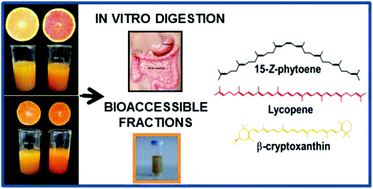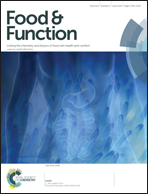Carotenoid bioaccessibility in pulp and fresh juice from carotenoid-rich sweet oranges and mandarins†
Abstract
Citrus fruits are a good source of carotenoids for the human diet; however, comparative studies of carotenoids in different citrus food matrices are scarce. In this work the concentration and bioaccessibility of carotenoids in sweet oranges and mandarins with marked differences in carotenoid composition were evaluated in pulp and compared to those in fresh juice. The pulp and juice of the red-fleshed Cara Cara sweet orange variety was highly rich in carotenes (mainly lycopene and phytoene) compared to standard Navel orange, while β-cryptoxanthin and phytoene predominated in mandarins. Total carotenoid content in the pulp of the ordinary Navel orange and in the red-fleshed Cara Cara orange, as well as in the Clementine mandarin were higher than in the corresponding juices, although individual carotenoids were differentially affected by juice preparation. Bioaccessibility of the bioactive carotenoids (the ones described to be absorbed by humans) was greater in both pulp and juice of the carotenoid-rich Cara Cara orange compared to the Navel orange while increasing levels of β-cryptoxanthin were detected in the bioaccessible fractions of pulp and juice of mandarins postharvest stored at 12 °C compared to freshly-harvested fruits. Overall, results indicated that higher soluble bioactive carotenoids from citrus fruits and, consequently, potential nutritional and health benefits are obtained by the consumption of pulp with respect to fresh juice.



 Please wait while we load your content...
Please wait while we load your content...